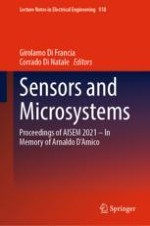This book showcases the state of the art in the field of sensors and microsystems, revealing the impressive potential of novel methodologies and technologies. It covers a broad range of aspects, including: bio-, physical and chemical sensors, actuators, micro- and nano-structured materials, mechanisms of interaction and signal transduction, polymers and biomaterials, sensor electronics and instrumentation, analytical microsystems, recognition systems and signal analysis and sensor networks as well as manufacturing technologies, environmental, food, energy and biomedical applications. The contents reflect the outcomes of the activities of AISEM (Italian Association of Sensors and Microsystems) in 2021.
Co-Edited by B. Andò, F. Baldini, G. Betta, D. Compagnone, S. Conoci, E. Comini, V. Ferrari, E. La Salandra, L. Lorenzelli, A.G. Mignani, G. Marrazza, G. Neri, P. Siciliano.
